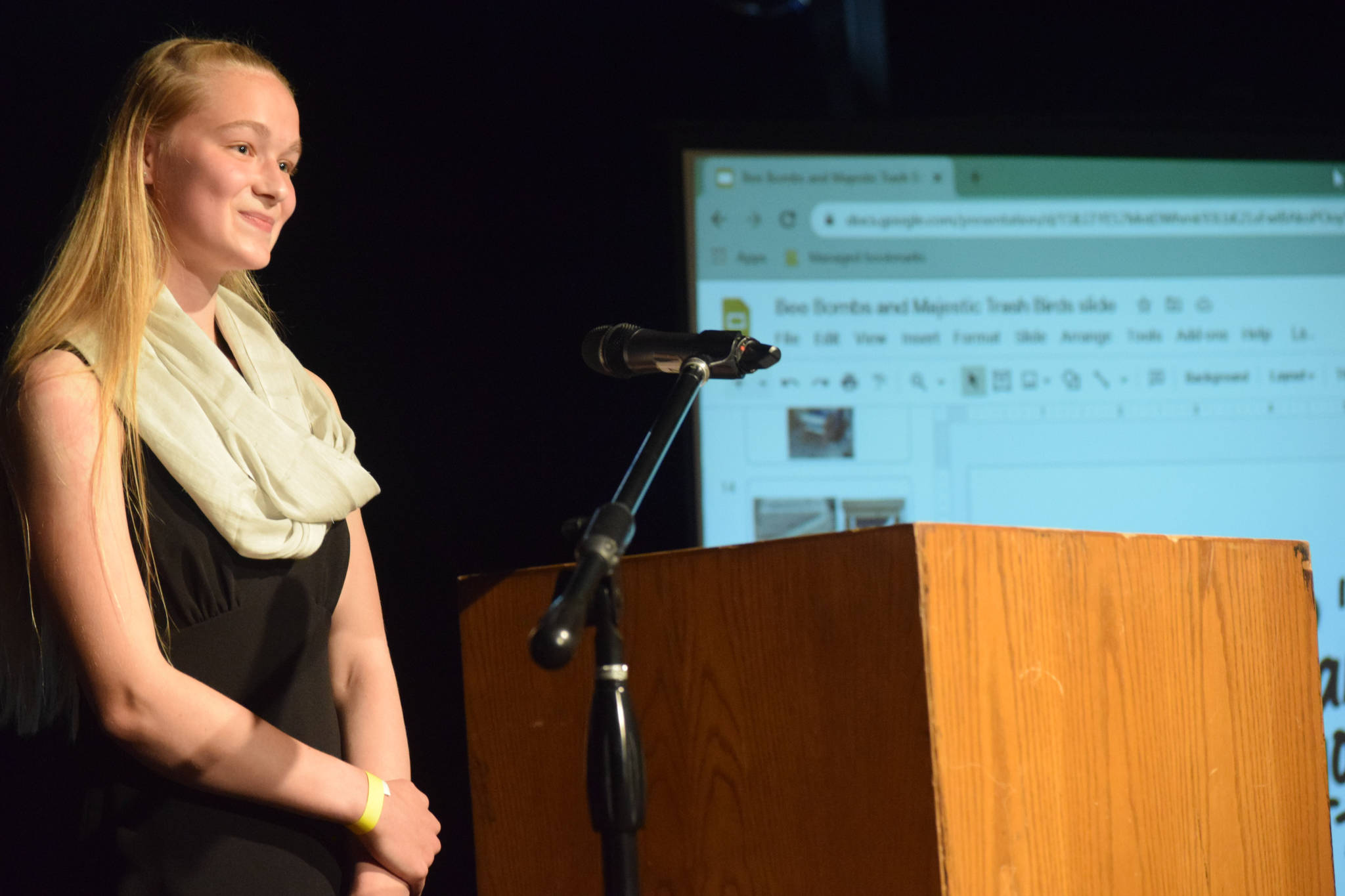Emily Moss took home first place at the annual Caring for the Kenai environmental competition at Kenai Central High School on Wednesday night, winning $1,600 for her idea.
The competition, which was streamed live on the foundation’s Facebook page because of the coronavirus pandemic, featured 12 students from across the peninsula who presented solutions to environmental issues and natural disasters.
“I was really surprised,” Moss told the Clarion of her first-place prize. “There were a lot of really good projects.”
The Kenai Central High School freshman’s project, Bee Bombs, served as both an environmental and human health solution to the pathogens spread by birds around the peninsula.
Moss aims to create and place beehives around different landfills in the area, in an effort to reduce the number of birds who eat and congregate around dumps. When the birds are exposed to hazardous metals in the landfills, Moss explained in her presentation, their fecal matter can spread mutated antimicrobial resistant bacteria impervious to antibiotics, which can be harmful to humans and the aquaculture along the Kenai River.
She told the Clarion that she got the idea after her biology class watched a video about people using beehives to divert elephants from their villages in Africa.
Bees are a useful tool in deterring birds away from the landfills, Moss said on Wednesday during her presentation for judges.
Scoring the contestants were Kenai Peninsula Borough Assembly President Brent Hibbert, Kenai Watershed Forum Director Branden Bornemann, last year’s competition winner Anna Devolld, Kenai River Raven Lodge staff member Dick Erkeneff, Marathon Plant Manager Cameron Hunt, and Kenai Peninsula Borough School District’s incoming superintendent, Clayton Holland.
Moss also said she’s already contacted officials at landfills in the area, the Alaska Department of Fish and Game and different bird experts, and has secured private funding through her website, beebombs.weebly.com, to implement her project this summer.
Winning second place and $1,100 was Nikiski Middle/High School freshman Maggie Grenier, with her social media strategy, “Carol the Composting Cow.”
She showed judges how she plans to effectively promote composting on social media, using Carol the cow as her mascot, to create more sustainable communities around the peninsula.
“I was not expecting to place second,” Grenier said in a statement. “My goal was to be confident in my project, do my best and enjoy the experience.”
Coming in at third place with a $900 cash prize was Nekoda Cooper, with her vision for turning imperfect produce into options for everyone to enjoy.
Cooper said on Wednesday during her presentation that while working around her family’s farm, she’s seen produce get trashed because it’s not visually appealing enough to sell. This inspired her to create her imperfect produce business, create a cookbook and sell her food for low prices at the Soldotna Wednesday Market.
She sells cabbage, lettuce and cucumbers anywhere from 50 cents to a dollar, tomatoes and carrots by the pound for around $2, and homemade jam for $8.
Cooper told the Clarion she wanted to beat her ranking at last year’s Caring for the Kenai competition, in which she won fourth place.
“It was really exciting being backstage with the final three,” she said. “I feel very lucky to have gotten that experience.”
Fourth place went to Regan Evans, a sophomore at the Connections Alaska Homeschool Program, who was the first Caring for the Kenai finalist in 31 years to make the top 12 with two separate ideas.
The submission that awarded her fourth place was a sustainable solution to the peninsula’s homelessness issue. Evans proposed building Conestoga micro-shelters for people experiencing homelessness, and insulating them with recycled denim, which, she said during her presentation on Wednesday, often outperforms fiberglass.
“Isn’t it poetic that our old clothing that has been cast aside can be given new life to bring warmth and shelter to those members of our community that have too often themselves been cast aside?” she said in front of the judges.
Evans was also a finalist for the competition last year, where she made a documentary to raise awareness about the peninsula’s homeless population. In an interview with the Clarion, she said she expanded on her idea from last year to design the micro-shelters.
This year she took home $750 for her micro-shelter idea, and an additional $400 for her second idea: a school reforestation initiative to plant trees as a community.
Abigail Youngberg and Lauren Lamb won the fifth prize of $650, and Tatum Rozak won the sixth prize of $550.
The additional Caring for the Kenai runner-ups each received $400 for making the top 12 with their ideas. They were Giaseena Nicks, Olivia Etzwiler, Hannah Stonorov, Jessica Perry and Seamus McDonough.
Reach reporter Camille Botello at camille.botello@peninsulaclarion.com.

